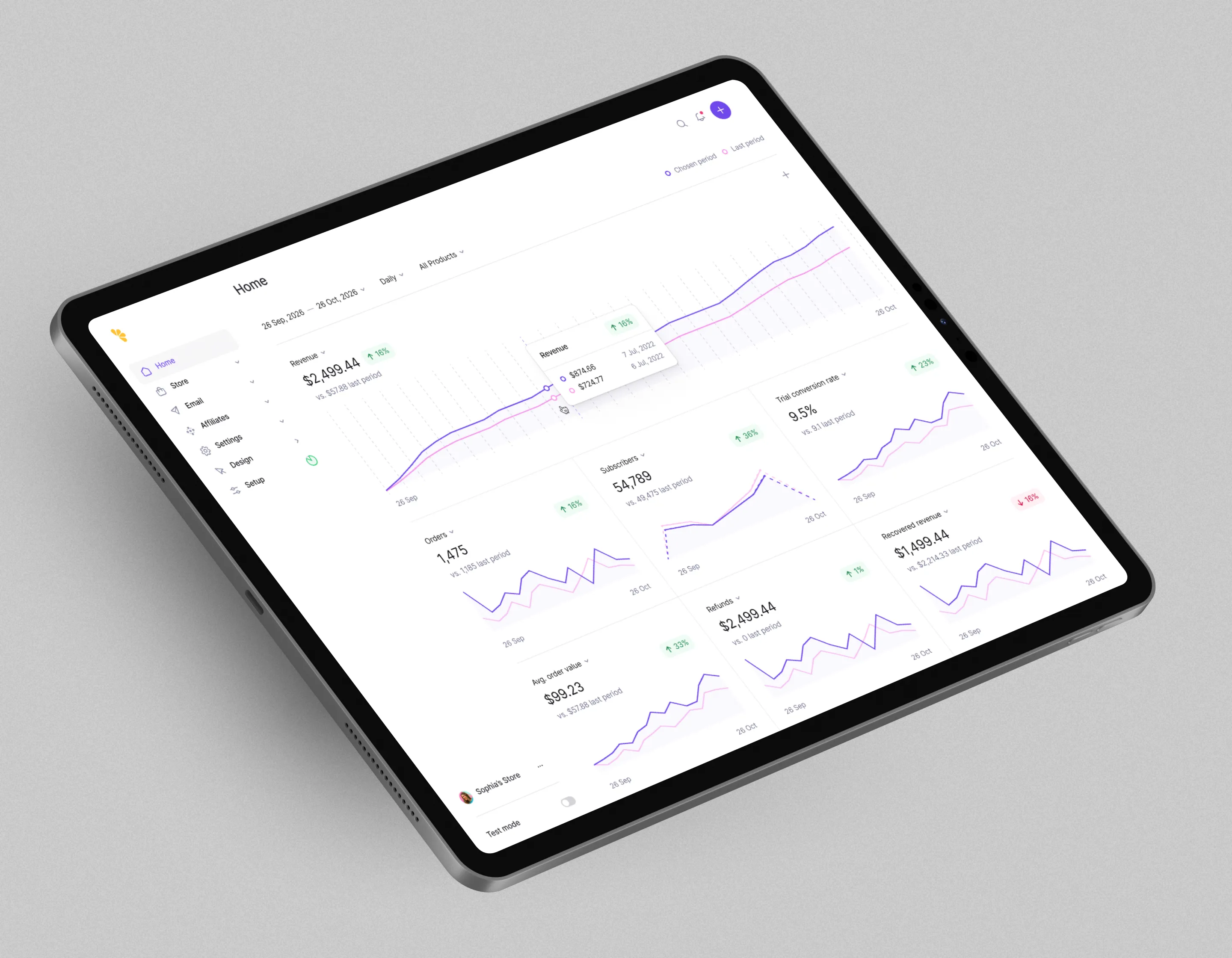
How to calculate churn — Keep it simple
Author
Date
Category
As a SaaS company churn is a number you not only need to know but that you need to be sure is 100% accurate.
By the time you’re done with the article, there’s one important point we hope to drive home. When it comes to how to calculate churn, keep it simple.
It’s more important that you’re actually keeping your finger on the pulse when it comes to your churn rates than having some complicated, predictive modeling method. We get it can be overwhelming but it can be a moving target.
As a SaaS company, it’s a number you not only need to know but you need to make sure it’s accurate. When you keep the calculation simple, you’re more likely to avoid the costly mistake of a false positive with your churn rate metrics.

Understand why churn matters when you calculate churn
“Churn” is a loaded word as it relates to the SaaS industry and your business. Despite the importance of SaaS churn, it can be a complicated metric to discuss if referenced in a nonspecific way. Because there are several different types of churn, there are also a few different ways how to calculate churn. Each of these formulaic methods yields a number with a slightly different meaning as churn relates to your customers, your revenue, or your daily, weekly, monthly performance versus annual results.
According to a survey performed in 2016, 39% of the most quickly-growing SaaS companies succeeded in keeping their annual revenue churn below 5%. You can be sure that these companies understand churn and how to use formulas and analytics to their advantage. And that’s exactly what we want to help you understand how to properly calculate churn.
Before we dive into the different ways to calculate churn, let’s make sure we’re thinking about everything in the same way. Also, we want to make sure you consider the different timeframes, types of customers, etc.
How are you counting a customer as a ‘customer’?
Believe it or not, it’s hard to say how many customers you have in a given timeframe. Take last month, for example, you have an existing base, new customers, and customers that canceled. Make sure you’re thinking about your customers in simple buckets like this.
- New
- Existing
- Churned
This affects your churn rate in a number of ways because of the type of customers you’re counting. New customers tend to churn at a higher rate whereas existing customers can be considered more “sticky”. In the case where you’re signing up a large number of new customers each month, it can affect your churn rate numbers because of how much it can misrepresent the overall number.
How are you defining churn as ‘churn’?
We think about churn in a few different ways.
- Customer makes a voluntary choice to cancel their subscription. This is typically classified as voluntary churn.
- Customer subscription ends or there’s an issue with the renewal. Payment issues are considered involuntary churn.
This is important to consider because a lot of times when a customer cancels their subscription, they more than likely haven’t churned because they’ve already paid for their existing month.
With all that said, let’s finally dive into the nitty-gritty of calculating churn.
4 ways on how to calculate churn
Now that we’ve given context on why it’s important to keep it simple, how to count customers, etc. we’ll tackle four different ways how to calculate churn. We will briefly describe how these calculations relate to your SaaS company’s success so that you, too, can be on your way to becoming a fast-growing service with minimal churn.
1. Monthly customer churn (or logo churn)
In order to calculate churn as it relates to the number of customers lost during a particular period of time, you’ll need two numbers: the total number of customers at the start of the chosen time period and the number of customers who unsubscribed from your service during the same time period.
Let’s walk through an example. In this scenario, let’s say you want to calculate customer churn for the month of September. Imagine the following scenario:
You began the month of September with 100 clients. During September, 7 of these customers unsubscribed.
Number of Unsubscribers in a Given Month / Number of Customers at the Start of that Month = Monthly Customer Churn
To calculate the monthly churn rate, divide the number of customers lost by the number of customers you began with. In this case, that’s 7/100, or a 7% monthly customer churn rate.
2. Annual customer churn
Understanding how a maintained monthly churn rate can affect you over the course of a year is equally important. While a 7% monthly churn rate seems pretty minimal, let’s consider an example where this rate is maintained over a period of 12 months.
To convert monthly churn to annual churn, use the following equation:
1 – (1 – Monthly Customer Churn)^12 = Annual Customer Churn
By using the result of our previous example, we find that:
1 – (1 – 0.07)^12 = 0.58, or 58% Annual Customer Churn
Yikes! While 7% didn’t seem like such a bad number, this kind of major annual churn is what can happen if 7% monthly customer churn is maintained throughout the year.
Another way to look at that is let’s say you signed up 100 customers in January. That means by December, you’d have 42 customers left by the end of the year.
3. Revenue churn (or MRR churn rate)
While similar to customer churn, revenue churn isn’t quite the same. Since revenue churn measures revenue lost from unsubscribing customers as well as customers who have chosen to downgrade, it’s important to consider revenue churn along with customer churn for a fuller picture of how your business is doing.
You may also hear revenue churn referred to as the MRR (monthly recurring revenue) churn rate.
The formula to calculate revenue churn is very similar to the formula we used for customer churn.
Churned MRR / Previous Month’s Revenue = % MRR Churn Rate
Time for another example. Imagine that we want to calculate the MRR churn rate for the month of April. If your MRR in March was $1,000 and your April MRR is $800, calculate your churned MRR by subtracting April’s MRR from March’s MRR.
Previous Month’s MRR – Current Month’s MRR = Churned MRR
$1,000 – $800 = $200
April’s churned MRR is $200. Now, divide $200 by the previous month’s revenue, $1,000. Your % MRR churn rate for April, then, is 20%. This isn’t a great number by any means—in fact, the best SaaS companies maintain a monthly revenue churn of only 0.58%, which translates to about 7% revenue churn annually.
4. The fabled net negative churn
This type of churn is different from all the others—it means that you’re in the green. If you consider your company’s expansion revenue (upgraded subscriptions, add-ons, or other positive growth from existing customers) along with your lost revenue for a given time period, you already have everything you need to calculate net negative churn.
Lost Revenue – Expansion Revenue = Net Negative Churn
You can measure each of these values as a percentage or even in a dollar amount. If your expansion revenue is larger than your lost revenue, you will receive a negative churn. How’s that for some company success?
To further understand the power of achieving net negative churn, check out this post on why net negative churn is so powerful.
Wrapping up. Remember, keep it simple.
As we’ve walked through some examples, you may have thought, “Wow, each of these measurements would be great to know and track,” and you are absolutely right. Maintaining knowledge of each type of churn and paying careful attention to the differences can yield a great deal of information about your business and where it’s heading.
Calculating churn doesn’t end with a set of numbers—it ends with understanding the results and why they are what they are, then taking action to optimize them.
Knowing your formulas means little if you have no idea how to act on your findings, but with some smart planning and accurate metrics, it can help you get your business to where you want it to be.
Whatever stage of your journey, we’re here to help
No matter the stage of your company, we stand behind our promise to provide exceptional customer support, from initial setups to massive migrations and everything in between.
Invest in your business with peace of mind that we're here for you whether you need technical help or business advice.

Creator Guide
Looking for some advice on how to sell and market your digital products? Download the creator’s guide to dive deep into getting your idea off the ground.

Merchant of Record Guide
Free guide for all entrepreneurs and organizations explaining why partnering with a Merchant of Record is more important than you might realize.

Want merch?
Want some fresh Lemon Squeezy swag with all the lemon puns you could ever imagine? The wait is almost over as we’re gearing up for a limited-time merch drop.

Book a demo today and get your own personal guided tour of Lemon Squeezy
Still have questions about Lemon Squeezy? Book a call with our sales team today and we’ll show exactly how we can revolutionize the way your business handles global payments and sales tax forever.

Need help?
If you’re looking to get in touch with support, talk to the founders, or just say hello, we’re all ears.









